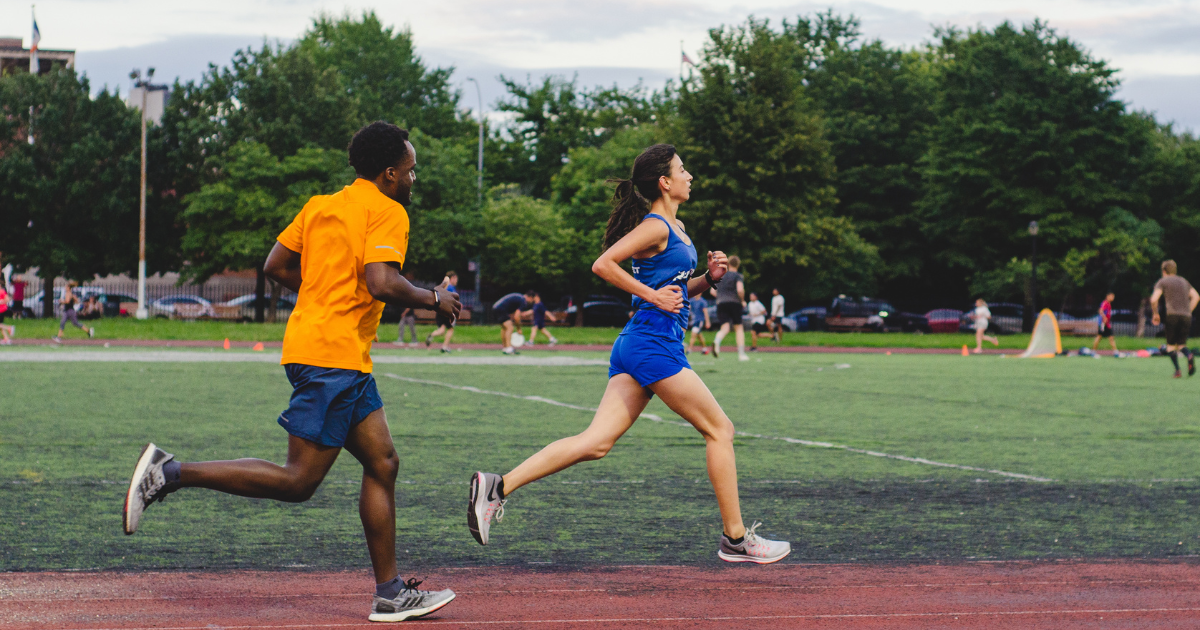Speed Training Workouts and Tips from a Trainer
Photos by Marques Jackson Photography.
By Marnie Kunz
NASM-certified trainer, USATF- RRCA-certified run coach
Speed training is helpful for runners, other athletes, and anyone interested in reaching higher levels of fitness. Whether you want to improve your race times, enjoy better performances in team sports, or burn calories and build stronger muscles, speed workouts will help. Speed training can also assist with weight loss goals since the high intensity burns a lot of calories. In my experience coaching runners, most people do speed work to get faster and improve their race times. Whatever your reasons for speed workouts, this guide will go over the benefits and offer free workouts you can try, as well as tips to minimize your risk of injury and get the most out of your training.
Speed workouts will help you run faster in races.
Related Post: 10 Running Workouts to Build Speed and Endurance
What Is Speed Training?
Speed training is a form of fitness training that includes workouts designed to improve your running speed. Speed work can consist of different types of training, including:
Interval training, which involves bursts of speed followed by periods of recovery. Sprint workouts and other running interval programs fall into this category.
Plyometric exercises, which use explosive movements to build your power and speed.
Strength training is a complementary form of training that improves your leg strength so you can run faster and more efficiently.
This guide covers all these types of speed training, and I’ve included my top workouts for each form of training. In addition to these workouts, following a complete nutrition program will help your muscles get stronger and perform at their best. Include plenty of protein in your daily diet to boost your performance and recovery.
Benefits of Speed Work
Speed training offers many benefits, from improving your running economy and form to helping you run faster in races ranging from the mile to the marathon. Here are some of the key benefits of doing regular speed work:
Better running form. Speedwork improves your leg strength and efficiency, helping you to run better. This means you’ll be able to run through fatigue more easily and not feel tired as early as you used to during hard training runs and races.
Faster running pace. Speed work is the best way to become a faster runner and get your best race times. Regular speed workouts will help you run faster in races and regular-paced training runs.
Stronger, more defined lower body muscles. According to the American Council on Exercise, sprints and speed workouts help to build muscle, combatting the effects of muscle loss that come with age. Stronger muscles also burn more calories and help you maintain a higher fitness level.
Speed training can help with weight loss because the high-intensity effort of acceleration to run faster burns more calories than slow, relaxed-pace running. Indeed, a speed interval workout is a form of HIIT training that will rev up your metabolism and burn a lot of calories.
Dynamic stretches will help you prepare for speed workouts.
Related Post: 10 Ways to Calculate Body Fat
Warm Up Before Speed Training
It’s essential to warm up before doing speed training. You don’t want to suddenly go from doing nothing to sprinting, as your muscles will be cold and more likely to tear. Do some dynamic stretches before your speed workouts.
Dynamic stretches involve continuous movement and improve the range of motion in your muscles and joints. Some great dynamic stretches to do before speed work include high knees, butt kicks, and A skips.
Related Post: Best Dynamic Stretches for Runners
Running Speed Workouts
If you want to get faster, add some of these speed workouts to your program. If you need a professionally designed training plan, head to the Runstreet Training Center for the best plan to suit your fitness level and goals.
Interval Training
Intervals are bursts of speed followed by recovery periods of jogging at an easy pace or walking. Interval training sessions offer an excellent way to improve your speed while mixing up the monotony of slower running workouts. A fartlek workout, short sprint workout, or 400-meter intervals are beginner-friendly ways to ease into interval training.
Here are some interval running workouts you can do:
400-Meter Interval Workout
This 400-meter workout can be adapted for any fitness level.
You can do this speed workout on a standard outdoor track where one lap equals 400 meters. Or use a GPS watch or treadmill to measure your distance.
Warm Up: Run for 10 minutes at a relaxed, slow pace. Do dynamic stretches.
Run 400 meters at 80% effort level or 5K race pace.
Jog 400 meters slow to recover.
Repeat to do 6 fast intervals and 6 recovery segments.
Cool down: Run for 10 minutes at a relaxed, slow pace. Stretch.
Sprint Ladder Workout
A ladder workout starts with shorter intervals, moves up to longer distances, and then returns to the shorter-distance intervals. You can do these ladder drills on a track or program it into your GPS watch for a road workout. If you have a Garmin watch, check out my article on How to Program Garmin Workouts for help.
Ladder workouts add variety to your training.
Warm Up: 800 meters relaxed pace run to warm up (20-40% effort level). Dynamic stretches.
Run 100 meters (1/4 of a lap on a standard track) at 95% effort level.
Jog 100 meters slow/recovery (20-40% effort).
Run 150 meters fast (95% effort level).
Jog 150 meters slow/recovery.
Run 200 meters (1/2 lap) fast (95% effort level).
Jog 200 meters slow/recovery.
Run 150 meters fast (95% effort level).
Jog 150 meters slow/recovery.
Run 100 meters fast at 95% effort level.
Jog 100 meters slow/recovery.
Cool down: 800 meters (2 laps), relaxed pace run to cool down (20-40% effort level). Stretch.
Fartleks Workout
Fartleks is Swedish for “speed play.” This form of interval training involves doing short bursts of speed during your regular, relaxed-pace run. To do a fartlek workout, you can informally pick objects to accelerate and run fast to during your regular run. Or, you can take a more measured approach and do a set period of regular running followed by a short sprint and repeat.
Here is a sample fartleks workout:
Fartleks are an adaptable speed workout.
Warm Up: 10 minutes relaxed pace run to warm up (40-50% effort level).
Run 1 minute fast (90% effort level).
Jog for 3 minutes at a relaxed pace (40-50% effort level).
Repeat for a total of 8 fast intervals and 8 relaxed pace segments.
Cool Down: 6 minutes relaxed pace run to cool down (40-50% effort level). Stretch.
Plyometrics Exercises for Speed
Plyometric exercises will improve your explosive speed. These speed drills train your body to perform well for explosive movements, optimizing your power and speed.
According to researchers, plyometric exercises increase neuromuscular coordination by training your nervous system and making movements more automatic during activity. This means you’ll have better balance and coordination when you run.
Here are some plyometric exercises that will help you get faster:
Squat jumps
Skater hops
Toe taps
Lunge jumps
Frog jumps
Tuck jumps
Box jumps
Check out our article with the 10 Best Plyometric Exercises to Get Faster for a detailed list with how-to instructions.
Strength Training for Speed
Strength training is essential for getting stronger and faster. Do these strength training exercises to improve your running form and speed. I recommend strength training at least twice per week for optimal results. You can use your bodyweight for these exercises or a pair of dumbbells (for the bench press and bent-over rows).
Lower body strength training exercises like squats and lunges target and strengthen your glutes, hamstrings, quads, and calves. These exercises will help you have more power and force when you run so you can run faster. Strength training is essential for a well-rounded sprint training program that gets results.
Squats
Lunges
Side lunges
Glute bridges
Planks
Push-ups
Bench press
Bent-over rows
How Often to Do Speed Training
If you’re a beginning runner, I recommend starting with a base fitness training program to improve your endurance for 4 to 6 weeks before adding speed workouts. If you’re a soccer player, basketball player, or regular runner, you will already have a base fitness program and can start adding speed to your training.
Start your speed training program with one speed workout per week, and then add another workout to do two speed sessions per week. You can adjust the frequency of your speed workouts and do up to three speed training sessions per week. For most runners, however, two speed workouts per week is a good amount.
Tips from a Run Coach to Improve Your Speed
Here are some quick tips to help you get faster and minimize your risk of injuries:
Follow a training plan. A structured training program designed by a fitness professional will help you make progress while reducing your risk of injuries.
Take rest days or easy days following speed workouts. This gives your body time to fully recover.
Add intensity gradually. If you’re new to speedwork, do a few fast intervals and gradually add more speed segments to your program as you make progress. Don’t start out with too many intervals as your body will need some time to adjust to speed workouts.
Be patient. It takes at least 6 weeks to start seeing the results of speed work, so stick with your program. It will be worth it, I promise!
Need a training plan to help you hit your goal pace in your next race? Visit the Runstreet Training Center for my customized training plans.
Follow and tag @Runstreet on Instagram to share your workouts and get cheered on.
Related Posts: Average 5K Time and How to Get Faster, 3 Track Workouts to Improve Your Race Times, How to Run by Perceived Effort Levels
Marnie Kunz is a NASM-certified personal trainer and USATF- and RRCA-certified running coach based in Brooklyn, NY. Marnie likes helping people get and stay active to enjoy a better quality of life. When she’s not doing fitness things, Marnie enjoys exploring with her dog, a mischievous rescue Akita.







